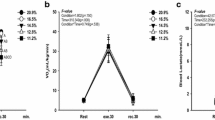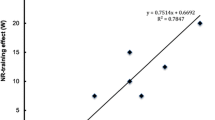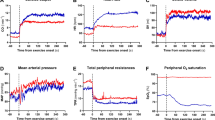Summary
In endurance trained (TR) and untrained (UTR) rats heart rate (HR) and respiratory rate (RR) were recorded during perfusion of the circulatorily isolated hind leg of the rat with exercise simulating modified tyrode solutions (TR: n=10, UTR: n=10; compare part I). During the 20 min test period and the preceding and succeeding periods of control perfusions with an unmodified tyrode solution, [lactate], pH, [K+], [Na+], PO2 and PCO2 were measured in the outflow of the femoral vein. In 3 experimental series: (1) hypoxic tyrode solution enriched with lactic acid (15 mmol·l−1), (2) normoxic solution with lactic acid, (3) hypoxic solution without lactic acid, were applied. The outflow parameters were cross correlated with both HR and RR. The analysis revealed a significant temporal relationship between [lactate], pH, PO2, PCO2 and [K+] and both HR and RR. In the trained rats no temporal correlation between either of the outflow and reflex parameters could be determined. This result was not due to low [lactate], but was also found during perfusion with lactic acid. In all 3 test conditions [lactate] in untrained individuals was best correlated with both HR and RR. Although the correlation peaks of the respiratory response, but not of the HR response were definitely lower in normoxic lactic and perfusion than in the two other experimental conditions, both inter- and intraindividual correlation analyses revealed a high degree of interdependence between respiratory and cardiac responses.
Similar content being viewed by others
References
Adams L, Garlick J, Murphy K, Semple SJG (1984) Is the voluntary control of exercise in man necessary for ventilatory response? J Physiol (Lond) 355:71–83
Astrand P-O, Ekblom E, Messin R, Saltin B, Stenberg J (1965) Intraarterial blood pressure during exercise with different muscle groups. J Appl Physiol 20:253–256
Davies KJA, Packer L, Brooks GA (1981) Biochemical adaptation of mitochondria, muscle, and whole-animal respiration to endurance training. Arch Biochem Biophys 209:539–553
Hultmann E, Sjöholm H (1982) Blood pressure and heart rate response to voluntary and non voluntary static exercise in man. Acta Physiol Scand 115:499–501
Karlsson J, Jacobs I (1982) Onset of blood lactate accumulation during muscular exercise. Int J Sports Med 3:190–201
Kaufman MP, Longhurst JC, Rybicki KJ, Wallach JH, Mitchell JH (1983) Effects of static muscular contraction on impulse activity of group III and IV afferents in cats. J Appl Physiol 55:105–112
Kniffki KD, Mense S, Schmidt RF (1978) Responses of group IV afferent units from skeletal muscle to stretch, contraction and chemical stimulation. Exp Brain Res 31:511–522
Lehmann M, Keul J, Huber G, Da Prada M (1981) Plasma catecholamines in trained and untrained volunteers during graduated exercise. Int J Sports Med 2:143–147
Leiner B (1976) Spectralanalyse. Einführung in Theorie und Praxis moderner Zeitreihenanalyse. Westdeutscher Verlag, Opladen
McCloskey DI, Mitchell JH (1972) Reflex cardiovascular and respiratory responses originating in exercising muscle. J Physiol (Lond) 224:173–186
Mense S, Schmidt RF (1984) Activation of group IV afferent units from muscle by algesic agents. Brain Res 72:305–310
Mitchell JH, Reardon WC, McCloskey DI (1977) Reflex effects on circulation and respiration from contracting skeletal muscle. Am J Physiol 233(3):H374-H378
Rybicki KJ, Kaufman MP, Kenyon JC, Mitchell JH (1984) Arterial pressure response to increasing interstitial potassium in hindlimb muscle of dogs. Am J Physiol 247:R717–721
Saltin V, Sjogaard J, Gaffney FA, Rowell LB (1981) Potassium, lactate and water fluxes in human quadriceps muscle during static contractions. Circ Res Suppl I 48:18–24
Stacey MJ (1969) Free nerve endings in skeletal muscle of the cat. J Anat 105:231–254
Stegemann J, Kenner T (1971) A theorie on heart rate control by muscular metabolic receptors. Arch Kreislaufforschung 64:185–214
Stegemann J, Ulmer H-V, Böning D (1967) Auslösung peripherer neurogener Atmungs- und Kreislaufantriebe durch Erhögung des CO2-Druckes in größeren Muskelgruppen. Pflügers Arch 293:155–164
Tallarida G, Baldoni F, Peruzzi G, Brindisi F, Raimundi G, Sangiorgi M (1979) Cardiovascular and respiratory chemoreflexes from the hindlimb sensory receptors evoked by intra-arterial injection of bradykinin and other chemical agents in the rabbit. J Pharmacol Exp Ther 208:319–329
Thimm F, Carvalho M, Babka M, Meier zu Verl E (1984) Reflex increases in heart-rate induced by perfusing the hind leg of the rat with solution containing iactic acid. Pflügers Arch 400:286–293
Thimm F, Dienstel E, Meier zu Verl E (1986) Heart rate changes caused by varying the oxygen supply to isolated hind legs of rats. Eur J Appl Physiol 55:273–280
Tibes U (1977) Reflex inputs to the cardiovascular and respiratory centers from dynamically working canine muscles. Circ Res 41:332–341
Tibes U, Hemmer B, Böning D, Schweigart U (1976) Relationships of femoral venous, [K+], [H+], PO2, osmolality, and [orthophosphate], with heart rate, ventilation, and leg blood flow during bicycle exercise in athletes and non-athletes. Eur J Appl Physiol 35:201–214
Tibes U, Hemmer B, Böning D (1977) Heart rate and ventilation in relation to venous [K+], osmolality, pH, PCO2, PO2, [orthophosphate], and [lactate] at transition from rest to exercise in athletes and non-athletes. Eur J Appl Physiol 36:127–140
Wildenthal K, Mierzwiak DS, Skinner NS Jr, Mitchell JH (1968) Potassium-induced cardiovascular and ventilatory reflexes from the dog hindlimb. Am J Physiol 215:542–548
Author information
Authors and Affiliations
Additional information
Dedicated to J. Stegemann on the occasion of his 60th anniversary
This work was supported by grants (No. 06/06040/68511) from the Minister für Wissenschaft und Forschung des Landes Nordrhein-Westfalen and the Görres Gesellschaft zur Pflege der Wissenschaft
Preliminary reports of this work was presented at the spring meetings of the Deutsche Physiologische Gesellschaft, March 1986, in Berlin and March 1987, in Homburg
Rights and permissions
About this article
Cite this article
Thimm, F., Gerber, B. Respiratory and cardiac responses to exercise-simulating peripheral perfusion in endurance trained and untrained rats. Europ. J. Appl. Physiol. 58, 112–119 (1988). https://doi.org/10.1007/BF00636613
Accepted:
Issue Date:
DOI: https://doi.org/10.1007/BF00636613




